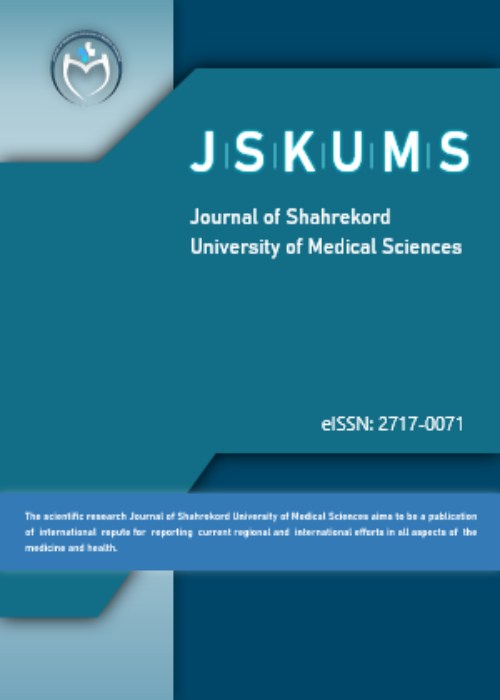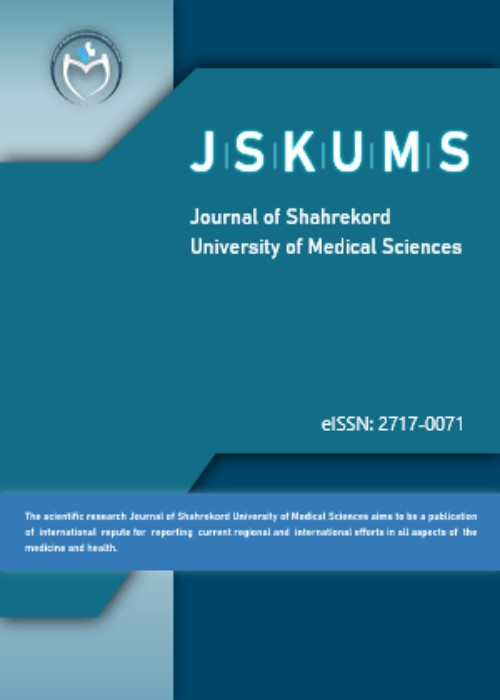فهرست مطالب

مجله دانشگاه علوم پزشکی شهرکرد
سال بیست و پنجم شماره 4 (پیاپی 121، Autumn 2023)
- تاریخ انتشار: 1402/08/13
- تعداد عناوین: 8
-
-
Pages 161-165Background and aims
One of the most important potential problems of radiotherapy is the heart problem caused by this treatment. Therefore, this research aimed to investigate the effect of 8 weeks of moderate-intensity endurance training on the serum levels of troponin I (TNI) and brain (B-type) natriuretic peptide (BNP) in rats undergoing radiation therapy.
MethodsIn this experimental study, 32 male rats (4-6 months) were randomly divided into four groups of eight, including healthy control (C), aerobic training (AT), radiotherapy (RT), and AT + RT groups. First, rats were anesthetized with ketamine-xylazine solution (K: 60-90 kg/mg, Z: 6-10 kg/mg) and then located on a Plexiglas plate with a thickness of 1 cm. Photon beam RT was performed using X-rays with a dose of 11 Gy from an Elekta compact linear accelerator (Elekta Compact 6-MV China). AT program was performed for eight weeks, five days a week, and one session a day for 60 minutes (70-75% of maximal oxygen consumption). Finally, one-way ANOVA was run to examine the research variables.
ResultsThe results showed that there was no significant difference between the groups in terms of the TNI level (P = 0.23). However, a significant difference was found in the amount of BNP between the RT and C groups (P = 0.009). In addition, no significant difference was reported in terms of BNP between AT + RT with AT (P = 0.99), RT (P = 0.32), and C (P = 0.69) groups, as well as between AT with RT (P = 0.1) and C (P = 0.99) groups.
ConclusionOverall, radiation therapy caused a significant increase in BNP, but it had no significant effect on TNI. Aerobic training did not significantly affect TNI and BNP in healthy rats and those undergoing radiation therapy.
Keywords: Radiation therapy, B-type natriuretic peptide, Troponin I -
Pages 166-171Background and aims
The α-actinin-3 (ACTN3) gene plays a key role in muscle signaling pathways and sarcomere contraction. Iranian weightlifters are among the most successful world and Olympic champions. Therefore, the present study was performed to compare the genetic profile of the single-nucleotide polymorphism of the ACTN3 gene in elite Iranian male weightlifters vs. non-athletes.
MethodsThis cross-sectional study was of a qualitative-quantitative type. Subjects included 30 volunteer elite male weightlifters, including all of Iran’s premier league, members of the national team, Olympic, world, and Asian champions of Isfahan province, with a mean age of 21.77 ± 7.11, the height of 179.87 ± 6.98, and the weight of 96.87 ± 22.73 (Mean ± SD) versus 30 volunteers available healthy non-athletes who were the same in age, height, and weight as weightlifters. After completing the consent form and physical health measurement questionnaire, participants’ saliva samples were collected, and DNA was extracted accordingly. Genotypes were determined after performing the polymerase chain reaction via the Tetra-Arms method and electrophoresis. Data were analyzed by SPSS (version 20) and the chi-square test (P < 0.05).
ResultsThe prevalence of the RR genotype in selected weightlifters (56.7%) was significantly higher than that of other genotypes (χ2 = 13.40, P = 0.03). There was a significant difference in ACTN3 R/X genotype distribution (P = 0.039, χ2 = 6.48) between weightlifters and non-athletes.
ConclusionA higher prevalence of the RR genotype of the ACTN3 gene in selected elite male weightlifters versus non-athletes can be likely considered for selecting genetically predisposed individuals.
Keywords: Sport genomic, Single-nucleotide polymorphism, Weightlifting, Elite, Non-athletes -
Pages 172-177Background and aims
The purpose of this study was to investigate the effect of 8-weeks of high-intensity interval exercise with L-cysteine (LC) consumption on interleukin (IL)-13 and hydrogen peroxide of the heart tissue in young rats with type 2 diabetes (T2D).
MethodsThe statistical population of the present study consisted of young (4-month) rats with T2D. Ten rats were selected as a healthy group. Forty rats became diabetic. Diabetic rats were randomly divided into diabetes control, diabetics with exercise, diabetics with supplements, and diabetics with exercise and supplements. High-intensity interval exercises were performed 3 days a week for 8 weeks, and 500 μmol of LC were injected daily.
ResultsThe healthy control group had lower IL-13 than the control group (P = 0.001). There was no significant difference in IL-13 between other groups. Based on the results, the diabetes control group had a higher H2O2 value than the healthy control group (P = 0.001). A significant difference was found between the exercise group + LC consumption compared to the diabetes control group, and the H2O2 levels in this group were less than the diabetic control group (P = 0.001). The exercise (P = 0.015) and LC (P = 0.001) groups had a lower H2O2 value than the diabetes control group. Eventually, the interval exercise group + LC was also lower than the periodic exercise group (P = 0.02).
ConclusionHigh-intensity interval training, along with the use of LC, reduced hydrogen peroxide in the heart tissue, while it had no significant impact on IL-13.
Keywords: Type 2 diabetes, IL-13, Oxidative stress, L-cysteine -
Pages 178-183Background and aims
Fatty diet can affect the expression of myokines. Thus, the aim of this study was to evaluate the effect of aerobic and resistance training secreted protein acidic rich in cysteine (SPARC), decorin (DCN), and myonectin muscle gene expression in rats fed with a high-fat diet.
MethodsIn this experimental study, 32 rats were randomly divided into healthy control, obese control, obese + aerobic exercise, and obese + resistance exercise groups. The training program was implemented for 4 weeks at aerobic moderate intensity (50% VO2max in the first week and 65% VO2max in the last week). For resistance training, the animals were also trained to climb the ladder (height 110 cm, slope 80%, and the distance between the bars of the ladder 2 cm), which is based on the determination of one-repetition maximum (1RM). Obese rats received a dose of 0.5 mL/100 g of body weight orally by gavage for 4 weeks and 5 days a week.
ResultsThere was no significant difference between the groups in terms of DCN expressions (P = 0.702). However, the expression of SPARC (P = 0.039) and myonectin in the obese control group was significantly increased compared to the healthy control (P = 0.038). The expression of SPARC and myonectin in the aerobic training group (P = 0.038, P = 0.042) and the resistance training group (P = 0.048, P = 0.049) was significantly decreased in comparison to obesity control. Resistance training caused a greater decrease in myonectin compared to aerobic training (P = 0.049).
ConclusionThe findings revealed that aerobic and resistance exercises are effective in reducing SPARC and myonectin expression in the skeletal muscle of rats fed with a high-fat diet.
Keywords: SPARC, Decorin, Myonectin, Obesity, Exercise training -
Pages 184-188Background and aims
Electroporation demonstrated certain modulable actions on tumoral cell membrane permeability to increase the intracellular bioavailability of chemotherapeutic drugs. The current in vivo study aimed to investigate the synergic effect of concomitant electroporation application to the intratumoral administration of cisplatin on murine invasive ductal adenocarcinoma breast cancer.
MethodsThe fragments of the extracted tumor were implanted subcutaneously in healthy female Balb/C mice. Having reached the determined tumoral volume, the mice were randomly divided into five groups, including control, intratumoral cisplatin injection, tumoral electroporation application, electrochemotherapy (ECT), and double course ECT. The normalized tumoral volume and the inhibition ratios were calculated during a 30-day follow-up period. The data were tested by ANONA, and a statistically significant level was set at P < 0.05.
ResultsThe inhibition ratio was significantly different between the intra-tumoral cisplatin administration and tumoral electroporation application groups compared to the control group (P < 0.05). ECT displayed superior results in comparison to the two later groups (P < 0.05). The double-course ECT group even represented a significant difference compared to the ECT group (P < 0.05).
ConclusionConcomitant ECT to the cisplatin intratumoral administration indicated contributive anti-tumoral impacts in an in vivo murine model of invasive ductal adenocarcinoma breast cancer. ECT promises further applications to overcome the occurrence of therapeutic resistance to chemotherapeutic drugs.
Keywords: Electroporation, Electrochemotherapy, Cisplatin, Ductal carcinoma -
Pages 189-193Background and aims
The present study aimed to compare the levels of the inflammatory biomarkers of fibrinogen and highsensitivity C-reactive protein (hs-CRP) among type 2 diabetic patients treated with empagliflozin and other hypoglycemic drugs.
MethodsThis cross-sectional study was performed on 90 patients with type 2 diabetes ( ≥ 30 years) receiving empagliflozin, metformin, and sulfonylurea who were referred to the diabetes clinics affiliated with Arak University of Medical Sciences. After obtaining consent to participate in the study, the patients were categorized into the treatment groups of metformin, metformin + empagliflozin, or metformin + sulfonylurea, and their characteristics and hypoglycemic drugs were recorded in the information checklist. The data were analyzed in SPSS 16 statistical software.
ResultsThe fibrinogen level was minimized in the metformin + empagliflozin group, although the three groups were not significantly different in this regard (P = 0.382). Based on the results, the parameter was higher in the individuals with ischemic heart disease, while a lower level was found among those treated with a lipid-lowering agent. In terms of hs-CRP level, no statistically significant difference was observed among the three groups, although the metformin group had a lower level (P = 0.522).
ConclusionThe minimum fibrinogen and hs-CRP levels were related to the metformin + empagliflozin and metformin groups, respectively. Further, several factors such as comorbidities and other consumed drugs could affect the concentration of inflammatory factors. Thus, it is suggested that clinical trials should be conducted in this respect.
Keywords: Empagliflozin, Fibrinogen, High-sensitivity C-reactive protein, Inflammatory factors, Sodium-dependent glucosecotransporter 2 inhibitors, Type 2 diabetes -
Pages 194-200Background and aims
The average age of the population and the number of elderly people have increased with increasing life expectancy. This study aimed to investigate the physical and mental health of the elderly in Chaharmahal and Bakhtiari province, which can provide important evidence for future interventions.
MethodsThis cross-sectional (descriptive-analytical) study was performed on 345 elderlies in Chaharmahal and Bakhtiari province in 2018. Census methods were used to select the samples according to the type of residence. Statistical analysis was performed using the Statistical Package for Social Sciences (IBM SPSS statistic, Chicago, IL, USA, version 22). Descriptive and analytical tests were performed using Chi-square, independent t-test, and analysis of variance.
ResultsThe mean age of participants and the mean score of their mental health were 71.13 and 55.29 ± 11.57, respectively. Diabetes and hypertension (HTN) (27.8%), followed by skeletal problems (11.3%), were the most frequent disorders in the participants. The findings of the study demonstrated a significant difference between depressive status, as well as anxiety and sleep disorders of the elderly in the home and those kept in the nursing home (P < 0.05).
ConclusionOverall, the elderly living in nursing homes had more unfavorable mental, emotional, and physical conditions than the elderly living in the home. Therefore, long-term planning to minimize the problems of elderlies is essential. Lifestyle modifications, health education, and screening for this age group are recommended to maintain independence, especially for the elderly in nursing homes.
Keywords: Physical health, Mental health, Elderly -
Pages 201-203
Resistant schizoaffective disorder has persistent psychotic symptoms and intermittent mood swings. A satisfying method for treating these patients is the use of the antipsychotic drug clozapine, but its use is limited due to significant side effects such as leukopenia and neutropenia. Lithium carbonate is another psychiatric drug that reduces these side effects. We hypothesized that lithium, along with clozapine, in addition to controlling side effects, could have a dual effect on mood episodes in schizoaffective disorder, and used it in a chronic case. The patient was a 48-year-old man with a 20-year history of the disease. Therefore, the use of lithium along with clozapine is recommended in refractory schizoaffective patients.
Keywords: Resistant schizoaffective, Clozapine, Leukopenia, Neutropenia, Lithium


